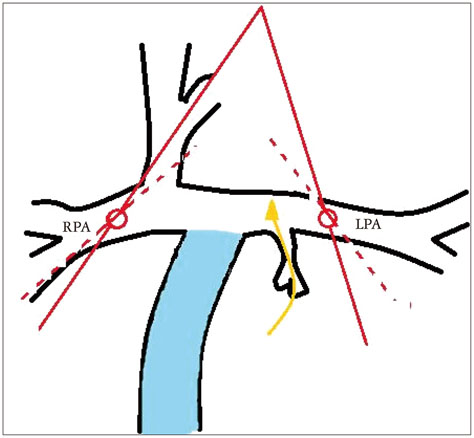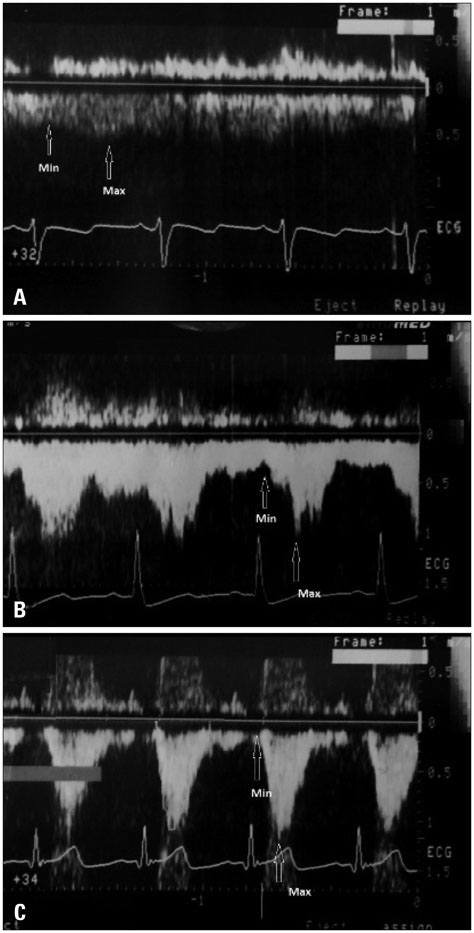J Cardiovasc Ultrasound.
2015 Dec;23(4):228-232. 10.4250/jcu.2015.23.4.228.
Echocardiographic Assessment of Pulmonary Arteries Pulsatility Index in Fontan Circulation
- Affiliations
-
- 1Department of Pediatric Cardiology, Children's Medical Center, Tehran University of Medical Sciences, Tehran, Iran.
- 2Department of Pediatric Cardiac Surgery, Children's Medical Center, Tehran University of Medical Sciences, Tehran, Iran. mirzaaghayanm@yahoo.com
- 3Department of Public Health, Alborz University of Medical Sciences, Karaj, Iran.
- 4Department of Pediatric Cardiology, Imam Khomeni Hospital, Tehran University of Medical Sciences, Tehran, Iran.
- KMID: 2144453
- DOI: http://doi.org/10.4250/jcu.2015.23.4.228
Abstract
- BACKGROUND
Late complications after Fontan procedure may be due to the absence of pump and pulsatile pulmonary blood flow in this type of palliation. Our aim was to quantify the degree of pulsation by echocardiographic method in patients with extracardiac total cavopulmonary connection (ECTCPC) in comparison with biventricular circulation and few cases of pulsatile Fontan.
METHODS
In a case series study, pulsatility index (PI) derived by echocardiographic method were compared between 20 patients with ECTCPC, 6 patients with pulsatile Fontan and 18 normal individual aged 4 to 20 years old. All patients were in New York Heart Association class of I and there was no report of complication.
RESULTS
In patients with ECTCPC pulmonary artery branches Doppler flow study showed lower peak and mean velocities compared to the pulsatile Fontan and normal groups. ECTCPC patients had PI of 0.59 +/- 0.14 and 0.59 +/- 0.09 for right and left pulmonary arteries (RPA and LPA) respectively. PI was higher in patients with preserved antegrade flow (RPA PI = 0.94 +/- 0.26, LPA PI = 0.98 +/- 0.27) and in normal individuals (RPA PI = 1.59 +/- 0.12, LPA PI = 1.64 +/- 0.17) for both branches (p = 0.000).
CONCLUSION
Using a Doppler derived index for pulsatility, patients with ECTCPC had the least pulsation. The pulmonary artery flow pattern in patients with preserved antegrade flow showed higher pulsatility indices in both branches. Normal individuals had the greatest pulsatility index.
Figure
Cited by 1 articles
-
Characterization of Flow Efficiency, Pulsatility, and Respiratory Variability in Different Types of Fontan Circuits Using Quantitative Parameters
Kee Soo Ha, Jae Young Choi, Se Yong Jung, Han Ki Park
Yonsei Med J. 2019;60(1):56-64. doi: 10.3349/ymj.2019.60.1.56.
Reference
-
1. Kaulitz R, Ziemer G, Luhmer I, Kallfelz HC. Modified Fontan operation in functionally univentricular hearts: preoperative risk factors and intermediate results. J Thorac Cardiovasc Surg. 1996; 112:658–664.2. Ovroutski S, Ewert P, Alexi-Meskishvili V, Hölscher K, Miera O, Peters B, Hetzer R, Berger F. Absence of pulmonary artery growth after Fontan operation and its possible impact on late outcome. Ann Thorac Surg. 2009; 87:826–831.3. Yoshida M, Yamaguchi M, Yoshimura N, Murakami H, Matsuhisa H, Okita Y. Appropriate additional pulmonary blood flow at the bidirectional Glenn procedure is useful for completion of total cavopulmonary connection. Ann Thorac Surg. 2005; 80:976–981.4. Gray RG, Altmann K, Mosca RS, Prakash A, Williams IA, Quaegebeur JM, Chen JM. Persistent antegrade pulmonary blood flow post-Glenn does not alter early post-Fontan outcomes in single-ventricle patients. Ann Thorac Surg. 2007; 84:888–893. discussion 893.5. Berdat PA, Belli E, Lacour-Gayet F, Planché C, Serraf A. Additional pulmonary blood flow has no adverse effect on outcome after bidirectional cavopulmonary anastomosis. Ann Thorac Surg. 2005; 79:29–36. discussion 36-7.6. Klimes K, Abdul-Khaliq H, Ovroutski S, Hui W, Alexi-Meskishvili V, Spors B, Hetzer R, Felix R, Lange PE, Berger F, Gutberlet M. Pulmonary and caval blood flow patterns in patients with intracardiac and extracardiac Fontan: a magnetic resonance study. Clin Res Cardiol. 2007; 96:160–167.7. Kurotobi S, Sano T, Kogaki S, Matsushita T, Miwatani T, Takeuchi M, Matsuda H, Okada S. Bidirectional cavopulmonary shunt with right ventricular outflow patency: the impact of pulsatility on pulmonary endothelial function. J Thorac Cardiovasc Surg. 2001; 121:1161–1168.8. Tamaki S, Kawazoe K, Yagihara T, Abe T. A model to simulate the haemodynamic effects of right heart pulsatile flow after modified Fontan procedure. Br Heart J. 1992; 67:177–179.9. Myers CD, Boyd JH, Presson RG Jr, Vijay P, Coats AC, Brown JW, Rodefeld MD. Neonatal cavopulmonary assist: pulsatile versus steady-flow pulmonary perfusion. Ann Thorac Surg. 2006; 81:257–263.10. Sakaki M, Taenaka Y, Tatsumi E, Nakatani T, Takano H. Influences of nonpulsatile pulmonary flow on pulmonary function. Evaluation in a chronic animal model. J Thorac Cardiovasc Surg. 1994; 108:495–502.11. Raj JU, Kaapa P, Anderson J. Effect of pulsatile flow on microvascular resistance in adult rabbit lungs. J Appl Physiol (1985). 1992; 72:73–81.12. Presson RG Jr, Baumgartner WA Jr, Peterson AJ, Glenny RW, Wagner WW Jr. Pulmonary capillaries are recruited during pulsatile flow. J Appl Physiol (1985). 2002; 92:1183–1190.13. Houlind K, Stenbøg EV, Sørensen KE, Emmertsen K, Hansen OK, Rybro L, Hjortdal VE. Pulmonary and caval flow dynamics after total cavopulmonary connection. Heart. 1999; 81:67–72.14. Kaulitz R, Bergman P, Luhmer I, Paul T, Hausdorf G. Instantaneous pressure-flow velocity relations of systemic venous return in patients with univentricular circulation. Heart. 1999; 82:294–299.15. Hager A, Fratz S, Schwaiger M, Lange R, Hess J, Stern H. Pulmonary blood flow patterns in patients with Fontan circulation. Ann Thorac Surg. 2008; 85:186–191.16. Ghoreyshi M, Saidi MS, Navabi MA, Firoozabadi BD, Shabanian R. Numerical investigation of antegrade flow effects on flow pulsations in Fontan operation. Int J Biomed Eng Technol. 2012; 10:221–238.
- Full Text Links
- Actions
-
Cited
- CITED
-
- Close
- Share
- Similar articles
-
- Fontan Procedure for Functional Single Ventricle with Major Aortopulmonary Collateral Arteries
- Pulsatility Index in Different Modifications of Fontan Palliation: An Echocardiographic Assessment
- Inhaled iloprost for the treatment of patient with Fontan circulation
- Characterization of Flow Efficiency, Pulsatility, and Respiratory Variability in Different Types of Fontan Circuits Using Quantitative Parameters
- Fontan Operation in a Case of Single Functional Pulmonary Artery



